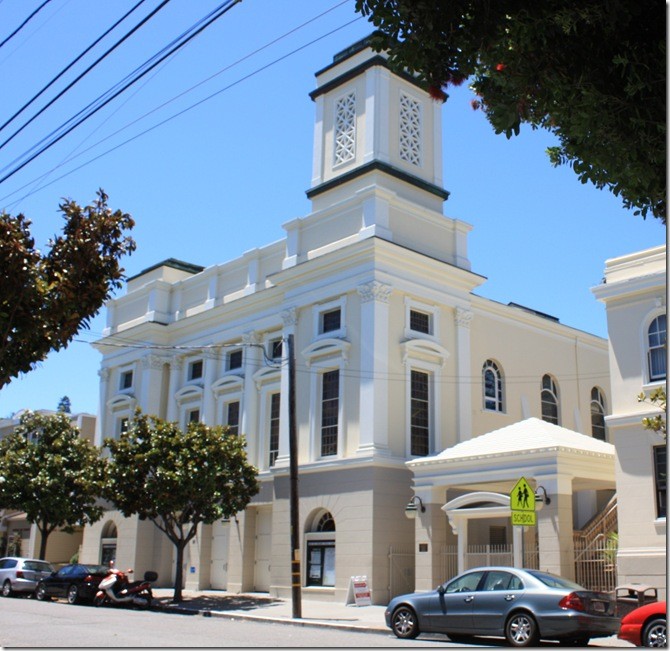Most Holy Redeemer Catholic Church
Introduction
Text-to-speech Audio
Images
Most Holy Redeemer Catholic Church

Interior of Most Holy Redeemer Church during a service

Backstory and Context
Text-to-speech Audio
Most Holy Redeemer Catholic Church was established in 1900 to serve as a parish for 370 Catholic families living in Eureka Valley. The church building was dedicated on Christmas Day of 1901. 16 years later, Most Holy Redeemer School was constructed across the street. Beginning in the 1950’s, the Castro District saw a major shift in its population demographics. During these years, Most Holy Redeemer became a haven to the remaining religious conservatism in the neighborhood. Tensions between the church and the area’s gay community culminated on April 30, 1961, when three teenage male students from Most Holy Redeemer robbed and threw a 27-year-old schoolteacher named William Hall onto tracks where he was run over and killed by a streetcar. During trial, the boys were unrepentant for their crimes and even argued that it wasn’t murder because the victim was reportedly homosexual. All three boys were convicted and went to a juvenile correctional facility, where they remained until June 30, 1976.
In 1979, Most Holy Redeemer School closed down due to a lack of students. The parish, meanwhile, was suffering from extremely low membership and attendance. This was the case until 1982 when, following the sudden death of the church’s pastor, Father Anthony McGuire was appointed to lead the congregation. In one of his first meetings with the congregation, he asked for each member’s advice regarding how to boost membership at Most Holy Redeemer. Although the group consisted mostly of elderly couples and women, one of the few gay men who attended the church stood up and recommended that more outreach be done to include the LGBTQ population of Castro in activities and services at Most Holy Redeemer.
The matter was put to a vote and passed unanimously. Most Holy Redeemer began hosting holiday parties and potlucks that featured LGBTQ speakers. The outreach was so successful that in 1983 the Board of Directors officially formed the Gay and Lesbian Outreach Committee- the first known committee of its kind in any Roman Catholic church. The remaining elderly members of the church- most of whom were widows- reportedly relished spending time with and doting after the influx of largely gay men who arrived at Most Holy Redeemer in the following years. The unlikely friendship between the two groups led Father Tony McGuire to nickname his congregation “the gays and the grays”.
Since this influx of gay men was occurring in the mid-1980’s during the beginning stages of the AIDS epidemic, a significant percentage of the church’s new parishioners had HIV/AIDS. Quickly, education meetings and support groups were created in response. Meal distribution and ride sharing programs were also established to help individuals who were in the final stages of life. The elderly women at Most Holy Redeemer were heavily involved in these programs, and would often spend hours visiting and cooking homemade meals for “their boys” in hospice. In 1987, Father McGuire did a forty-hour prayer service in honor of those who had AIDS. The service was repeated the next year, establishing it as an annual tradition which continues to this day.
In 1990, Father Tony McGuire stepped down and was replaced by Father Zachary Shore. Shore’s leadership during the 1990’s cemented Most Holy Redeemer’s position as a gay-friendly parish. In fact, by 1998, the number of gays and lesbians in Most Holy Redeemer's congregation was estimated by Shore to be as high as 80-90%, making Most Holy Redeemer the only known majority-out gay Catholic Church. Today, the church reportedly still has a similar demographic makeup. Hanging on the walls are photographs of many of the church’s former parishioners who died of AIDS. A scroll is also kept with the names, birthdates, and dates of death of each person. The AIDS support group at Most Holy Redeemer is still active, however with far less members nowadays thanks to the increased availability of preventative and therapeutic medications.
Sources
Godfrey, Donal. Gays and Grays: The Story of the Inclusion of the Gay Community at Most Holy Redeemer Catholic Parish in San Francisco. Edition 1st. Washington, District of Columbia. Lexington Books, 2007.
Most Holy Redeemer Catholic Church. History, Most Holy Redeemer Catholic Church. Accessed October 25th 2020. https://www.mhr.org/about-mhr/history/.
O'Loughlin, Michael. A gay Catholic Church in the Castro, America Magazine. December 22nd 2019. Accessed October 25th 2020. https://www.americamagazine.org/faith/2019/12/22/gay-catholic-church-castro.
http://jemamum.blogspot.com/2011/06/san-francisco-most-holy-redeemer.html
https://www.mhr.org/
